Fashions in the Show Ring
In attending Western horse shows around the nation, it is interesting to note how styles in fashions—and equipment—vary from one region to another. It is also interesting to observe how styles are changing in some regions where show rings are witnessing a trend to more-tailored outfits while satin, sequins, and fringe are on the way out.
 Carol Chapman, New Braunfels, Tex., is noted in Arabian circles for her distinctive taste in apparel. Here she is wearing brown roughout chaps with silver conchas, matching suede vest with silver conchas, and brown scarf and felt hat. The blouse is a white, man-tailored dacron. The bridle and reata are rawhide; and the bit has a Salinas mouthpiece with Santa Barbara cheeks. The saddle is tooled and silver-laced. Photo by Polter.
Carol Chapman, New Braunfels, Tex., is noted in Arabian circles for her distinctive taste in apparel. Here she is wearing brown roughout chaps with silver conchas, matching suede vest with silver conchas, and brown scarf and felt hat. The blouse is a white, man-tailored dacron. The bridle and reata are rawhide; and the bit has a Salinas mouthpiece with Santa Barbara cheeks. The saddle is tooled and silver-laced. Photo by Polter.
There are several reasons for style variations. For example, riders in a particular region might reflect the history and culture of that region. California riders are a good example of this. They reflect the Spanish influence of silver ornamentation, half-breed and spade bits, and finely-braided rawhide.
Rule books dictate what riders must wear and carry in some classes. For example, AHSA rules require riders to wear chaps in most Western classes, and to carry a rope or reata.
Another reason for style variation: the desire of a rider to be different—to wear something that will be unique and help catch the judge’s eye in a crowded class. This, in turn, helps establish new styles because riders who like to be different have a tough time staying different! When one rider comes out with something new, like chaps with silver conchas and a matching vest, it’s a sure bet that several riders at the next show will have the same thing. In this respect, horse show riders are unexcelled at “keeping up with the Joneses.”
If you were to divide the U.S. according to show ring fashions and equipment, there would be two basic regions: (1) California and several adjoining states, and (2) the rest of the nation. There is little difference in fashions and equipment found anywhere east of the Rockies. But California riders can be instantly identified.
 Pat Faitz, Mt. Pocono, Pa., with an outfit typical of eastern show rings. She is wearing a silver belly hat, button-down linen shit and ascot, blue hunt coat, gray dress pants, and alligator boots. The horse, Tabano Bay, is wearing a split-ear bridle with buckstitching. The bit is a regular curb with a special loop for the curb strap. A short coil of rope is carried on the saddle skirt, and the rear cinch has a case for a hoofpick. Photo by Morin.
Pat Faitz, Mt. Pocono, Pa., with an outfit typical of eastern show rings. She is wearing a silver belly hat, button-down linen shit and ascot, blue hunt coat, gray dress pants, and alligator boots. The horse, Tabano Bay, is wearing a split-ear bridle with buckstitching. The bit is a regular curb with a special loop for the curb strap. A short coil of rope is carried on the saddle skirt, and the rear cinch has a case for a hoofpick. Photo by Morin.
These riders and their horses are among the best-dressed and best-equipped in the nation. Riders tend to dress nicely and in good taste. Conservative Western shirts or tailored shirts are popular—with the regular bulldogger ties, or small scarves, worn as ties. Either dress pants or jeans are worn under shotgun chaps. The chaps may or may not have fringe, but their color complements the color of the horse and the rider’s shirt and hat. Gloves are often worn, which add to the well-dressed appearance. From head to toe, the typical California rider presents a well-coordinated outfit.
But it is the equipment, more than anything else, that identifies the Californians. Their bits usually have spade or half-breed mouthpieces; but the shanks come in a fascinating array of styles and are embellished with silver and sometimes gold. The designs are endless and so are the defects created by using engraved silver—either inlaid or overlaid—on bluedsteel, or regular steel, or iron. If you go into a California saddle shop, you can spend hours examining the bits alone.
In the days of early California, braided rawhide was a favorite with the vaqueros because it was tough, durable, and readily available. Rawhide is still popular today, but braided latigo and kangaroo are also being used for the show ring.
Braided headstalls, made of these leathers, are preferred by many because they are neat and enhance the appearance of a fine head. Silver-mounted bridles are also favorites. They come in either the split-ear or browband type, with rounded cheek pieces.
Saddles are usually hand-tooled and many have silver trim. Instead of a lariat, a short reata is carried in a neat coil. And hobbles are carried behind the saddle or attached to the rear cinch billet or D ring.
Reins and romals are also braided from rawhide, latigo, or kangaroo—and usually have rawhide knots and buttons for the sake of appearance, balance, and weight.
During the past few years, California equipment has made inroads into the Rocky Mountain region, and into Arabian horse shows almost everywhere. But with the exception of Arabian shows, it is still unusual to see this equipment anywhere east of the Rockies.
As mentioned earlier, styles in fashion and equipment are similar east of the Rockies and into the south. This is split-rein country. And bridles are usually the split-ear type, either plain, tooled, or buckstitched; or round with nickel or silver ferrules.
Bits are usually some type of curb; or the Western snaffle type (snaffle mouthpiece with shanks). The shanks come in a variety of styles and lengths, but are usually plain as compared to the ornate California bits.
Many saddles have full or partial tooling. Buckstitching is popular on show saddles—and often a rider will have a matching bridle, saddle, and breast collar with this stitching. Some saddles have silver conchas along with the silver-laced rope on the cantle, swells, and horn. Double Navajo blankets are popular and are often used with a hair pad. If rules call for a lariat to be carried, most riders carry a nylon or grass rope.
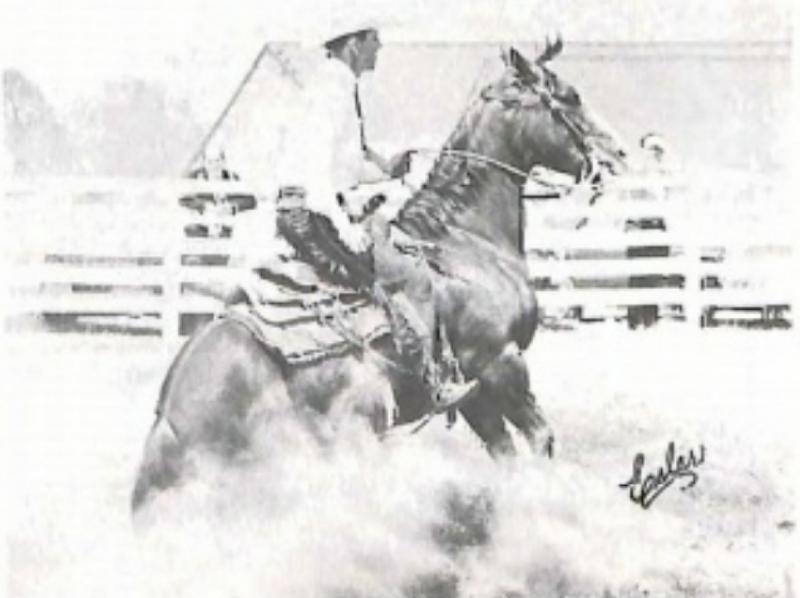
This is Paul Babington riding Elm’s Nylon Lady, reserve senior reining champion of Virginia last year. Paul is wearing a shirt with tie, jeans, and shotgun chaps with buckstitching and fringe. The bridle and reins are also buckstitched. Photo by Esler.
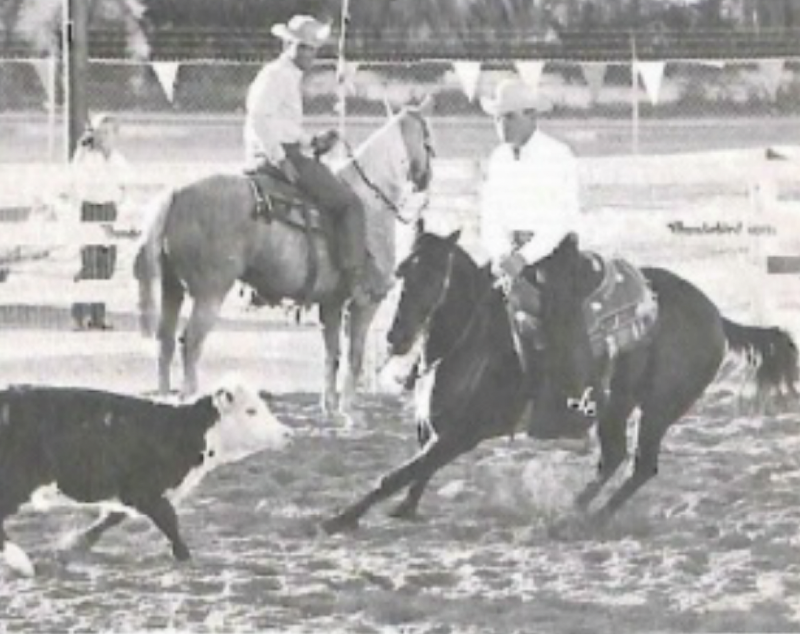 Buster Welch, Roscoe, Tex., typifies what cutting horse men like to wear: dress shirt or conservative western shirt open at the collar, jeans, and batwing chaps. Buster’s bridle and reins are buckstitched and the saddle has buckstitching and silver trim.
Buster Welch, Roscoe, Tex., typifies what cutting horse men like to wear: dress shirt or conservative western shirt open at the collar, jeans, and batwing chaps. Buster’s bridle and reins are buckstitched and the saddle has buckstitching and silver trim.
Fashions in riding apparel east of the Rockies present a wide range in taste and styles. Girls and women wear everything from tailored suits to plain jeans and shirts. Chaps, however, are being seen more and more; as in California, they complement the color of the horse and the rest of the rider’s outfit.
In the east, hunt coats are a distinguishing item, and are often worn with ratcatcher shirts and chokers. This style no doubt springs from the east being traditional hunt country. For pants, women like dress pants—often with bell bottoms—or plain jeans to be worn under chaps.
Men like conservative Western shirts or dress shirts. Collars are worn buttoned, with a bulldogger tie or four-in-hand tie, for such classes as pleasure; but un-buttoned for the working classes. More men seem to be wearing shotgun chaps for pleasure, trail, and reining; but chaps, of course, are impractical for the roping events.
For cutting, men like the batwing chaps. And if a feller wants to really dress up for a cutting performance, he will often wear a dress shirt, four-in-hand tie, and sports coat.
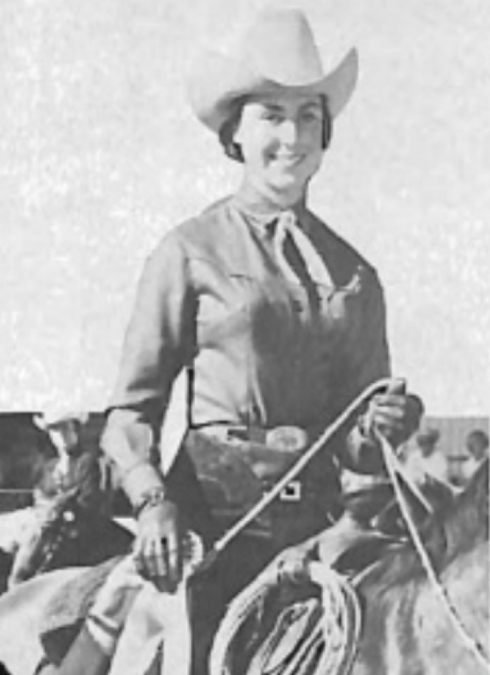 Millie Rudnick, Bakersfield, Calif., typifies the well-dressed California rider. Her tailored, medium brown shirt is of light-weight wool suiting. The scarf tie, with silver concha, is a buckskin color and matches the hat. Her chaps are dark brown roughouts and the gloves are calfskin. Photo by Fallaw.
Millie Rudnick, Bakersfield, Calif., typifies the well-dressed California rider. Her tailored, medium brown shirt is of light-weight wool suiting. The scarf tie, with silver concha, is a buckskin color and matches the hat. Her chaps are dark brown roughouts and the gloves are calfskin. Photo by Fallaw.
If the weather is cool, some men (and women) wear swearers—either the V-neck type or regular zipper or button front. Vests are also popular with a lot of riders. Usually the vest will complement the pants or chaps, and hat.
It goes without saying, of course, that hats and boots are mandatory. Felt hats are worn in the winter months, and straws in the summer.
Just about all equipment used by a rider is designed for a specific reason or function. For show purposes it is interesting to see why some equipment is used. A breast collar, for example, helps keep the saddle in place, especially in roping events—in addition to helping dress up an outfit.
Saddles come with round or square skirts. The kind that a rider prefers is usually a matter of individual choice; but the size of skirt should be in proportion to the horse’s size in order to enhance his appearance. For example, a larger horse looks better under a saddle having big, square skirts than he does with a saddle having small, round skirts.
The wide shanks on some of the half-breed and spade bits are not only ornate, but they also help prevent a horse from grabbing or lipping the shanks. Californians like heavy bits, and silver ornamentation adds to this weight.
Californians also like their horses to flex at the poll. This is accomplished through training; but the added weight from the rein chains and the buttons and knots on the reins helps keep the horse flexed.
The romal, on the end of the reins, can be used as a quirt. In fact, that’s how the romal came about. Vaqueros used to carry a quirt; but over the years the quirt was transformed into the romal and attached to the reins.
Chaps, of course, were originally designed to protect a rider in rough, bushy, or timber country, and from rain and cold weather. In years past, batwing chaps were by far the most popular as compared to the shotguns. This was because the shotgun chaps were so hard to get into. They were usually laced, and had to be stepped into and pulled up just like a pair of jeans. But the advent of full-length zippers made shotguns a snap to put on. Today they are the most popular with show ring riders because they are neat and less bulky than batwings.
Shotgun chaps can help a rider “adhere” to the saddle and keep a good seat. Leather for these chaps should be thin and lightweight, however. Thick, bulky leather can make it difficult to maintain a proper seat; and cause the rider to lose some of his feeling of contact with the horse.
It is true that it’s the performance of the horse that really counts in the show ring. But it pays for both horse and rider to look their very best—for those that look the best quite often are the best. Therefore looking your best can possibly subtly impress the judge so that he pays particular attention to your performance!
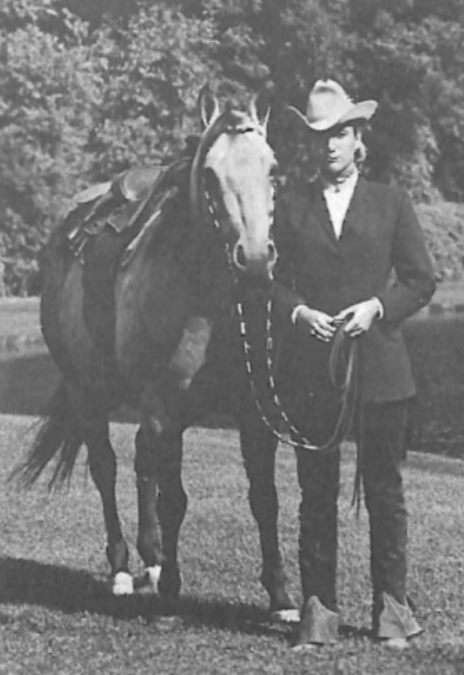 Holly Fuller, of Willow Brook Farms in Catasauqua, Pa., is wearing the hunt coat and choker which are popular with eastern riders. Her chaps have a flared bottom. The horse, Sappho Cody, has on a silver-mounted bridle with matching reins. There is a buckstitching on the saddle; and the saddle blanket is fringed.
Holly Fuller, of Willow Brook Farms in Catasauqua, Pa., is wearing the hunt coat and choker which are popular with eastern riders. Her chaps have a flared bottom. The horse, Sappho Cody, has on a silver-mounted bridle with matching reins. There is a buckstitching on the saddle; and the saddle blanket is fringed.
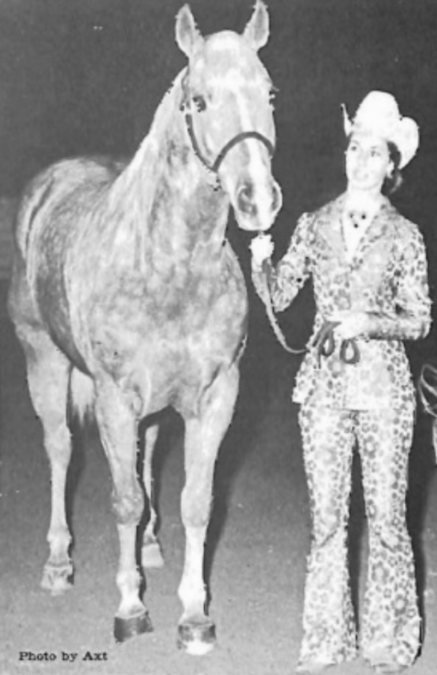 Kathy Gunson, Arvada, Colo., shown with Scamp’s Nugget, is one of the best-dressed riders in the Rocky Mountain region. Here she is wearing a moss green and gold suit of silk brocade—made by her mother—with a blouse and rhinestone pin. Her hat is pale yellow.
Kathy Gunson, Arvada, Colo., shown with Scamp’s Nugget, is one of the best-dressed riders in the Rocky Mountain region. Here she is wearing a moss green and gold suit of silk brocade—made by her mother—with a blouse and rhinestone pin. Her hat is pale yellow.
This article was originally published in the May 1968 issue of Western Horseman.
The post Fashions in the Show Ring appeared first on Western Horseman.
Mashups and APIs
- Home
- About Us
- Write For Us / Submit Content
- Advertising And Affiliates
- Feeds And Syndication
- Contact Us
- Login
- Privacy
All Rights Reserved. Copyright , Central Coast Communications, Inc.